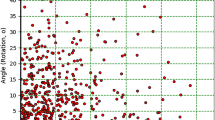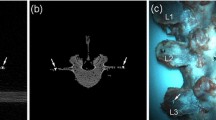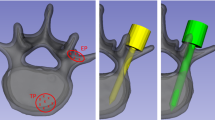Abstract
Purpose
The accuracy of pedicle screw placement during image-guided spine surgery (IGSS) can be characterized by estimating the target registration error (TRE). The major factors that influence TRE were identified, minimized, and verified with in vitro experiments.
Materials and methods
Computed-tomography-compatible markers are placed over anatomical landmarks of lumbar vertebral segments in locations that are feasible and routinely used in surgical procedures. TRE was determined directly for markers placed on the pedicles of vertebra segments. First, optimum selections of landmarks are proposed for different landmarks according to the minimum achievable TRE values in different configurations. These anatomical landmarks are feasible and accessible to overcome constraints that may be imposed during surgical procedures. Second, the effect of fiducial weighting on corresponding points to overcome anisotropic localization error based on maximum likelihood approach is evaluated. Third, an experimental model for fiducial localization error (FLE) is derived to obtain the weights. At the end, an error zone was obtained for each marker to indicate the possible acceptable deviation from the marker’s exact location in practice. This study was performed in vitro on a spine phantom.
Results
Optimal landmark selection led to a 30 % reduction in TRE. In addition, optimum weighting of the fiducials in an FLE model that incorporates anisotropic localization error in the registration algorithm led to a 28 % reduction in the TRE.
Conclusion
Landmark configuration, transformation parameters, and fiducial localization error are factors that significantly affect the total TRE. These factors should be optimized to minimize the TRE. Both the optimum configuration of landmarks and the anisotropic weighing of fiducials have significant impact on the registration accuracy for IGSS.





Similar content being viewed by others
Notes
Parseh Intelligent Surgical Systems, www.parsiss.com.
References
Tjardes T et al (2010) Image-guided spine surgery: state of the art and future directions. Eur Spine J 19:25–45
West JB et al (2001) Fiducial point placement and the accuracy of point-based, rigid body registration. Neurosurgery 48:810–816; discussion 816–817
Shamir RR et al (2009) Optimal landmarks selection and fiducial marker placement for minimal target registration error in image-guided neurosurgery. In: SPIE medical imaging visualization, image-guided procedures, and modeling
Shamir R et al (2009) Localization and registration accuracy in image guided neurosurgery: a clinical study. Int J Comput Assist Radiol Surg 4:45–52
Shamir RR et al (2012) Fiducial optimization for minimal target registration error in image-guided neurosurgery. IEEE Trans Med Imaging 31:725–737
Wang M, Song Z (2010) Guidelines for the placement of fiducial points in image-guided neurosurgery. Int J Med Robot 6: 142–149
Wang M, Song Z (2009) Improving target registration accuracy in image-guided neurosurgery by optimizing the distribution of fiducial points. Int J Med Robot 5:26–31
Wang M, Song Z (2010) Distribution templates of the fiducial points in image-guided neurosurgery. Neurosurgery 66:143–150; discussion 150–151
Zhang W et al (2011) Effect of fiducial configuration on target registration error in image-guided cranio-maxillofacial surgery. J Cranio-Maxillofac Surg 39:407–411
Fitzpatrick JM (2009) Fiducial registration error and target registration error are uncorrelated. In: SPIE 7261, medical imaging 2009: visualization, image-guided procedures, and modeling, 726102 (March 13, 2009). doi:10.1117/12.813601
Fitzpatrick JM, West JB (2001) The distribution of target registration error in rigid-body point-based registration. IEEE Trans Med Imaging 20:917–927
Moghari MH, Abolmaesumi P (2009) Distribution of target registration error for anisotropic and inhomogeneous fiducial localization error. IEEE Trans Med Imaging 28:799–813
Moghari MH et al (2008) A theoretical comparison of different target registration error estimators. Med Image Comput Comput Assist Interv 11:1032–40
Walker MW et al (1991) Estimating 3-D location parameters using dual number quaternions. CVGIP Image Underst 54:358–367
Arun KS et al (1987) Least-squares fitting of two 3-D point sets. IEEE Trans Pattern Anal Mach Intell PAMI–9:698–700
Horn BKP (1987) Closed-form solution of absolute orientation using unit quaternions. J Opt Soc Am A 4:629–642
Horn BKP et al (1988) Closed-form solution of absolute orientation using orthonormal matrices. J Opt Soc Am A 5:1127–1135
Balachandran R, Fitzpatrick JM (2009) Iterative solution for rigid-body point-based registration with anisotropic weighting. In: Miga MI, Wong KH (eds) Proceedings of SPIE 7261, medical imaging 2009: visualization, image-guided procedures, and modeling, 72613D, 13 March 2009. doi:10.1117/12.813887
Ohta N, Kanatani K (1998) Optimal estimation of three-dimensional rotation and reliability evaluation. In: Burkhardt H, Neumann B (eds) Computer vision–ECCV’98, vol 1406. Springer, Berlin, pp 175–187
West JB et al (2001) Point-based registration under a similarity transform. In: Proceedings of SPIE 4322, Medical Imaging 2001: Image Processing, 611, 3 July 2001. San Diego pp 611–622. doi:10.1117/12.431135
Maier-Hein L et al (2012) Convergent iterative closest-point algorithm to accommodate anisotropic and inhomogenous localization error. IEEE Trans Pattern Anal Mach Intell 34:1520–1532
Shamir RR et al (2009) Localization and registration accuracy in image guided neurosurgery: a clinical study. Int J Comput Assist Radiol Surg 4:45–52
Danilchenko A, Fitzpatrick JM (2011) General approach to first-order error prediction in rigid point registration. IEEE Trans Med Imaging 30:679–693
Maier-Hein L et al (2011) Iterative closest point algorithm with anisotropic weighting and its application to fine surface registration. In: Proceedings of the SPIE 7962, medical imaging 2011: image processing, 79620W (March 11, 2011). doi:10.1117/12.873060
Acknowledgments
The authors would like to thank the reviewers for carefully reading the paper and providing valuable comments and suggestions. The first author would also like to thank Professor J. Michael Fitzpatrick for helpful communication.
Conflict of Interest
Marzieh Ershad, Alireza Ahmadian, Nassim Dadashi Serej, Hooshang Saberi, and Keyvan Amini Khoiy declare that they have no conflict of interest
Author information
Authors and Affiliations
Corresponding author
Rights and permissions
About this article
Cite this article
Ershad, M., Ahmadian, A., Dadashi Serej, N. et al. Minimization of target registration error for vertebra in image-guided spine surgery. Int J CARS 9, 29–38 (2014). https://doi.org/10.1007/s11548-013-0914-7
Received:
Accepted:
Published:
Issue Date:
DOI: https://doi.org/10.1007/s11548-013-0914-7




